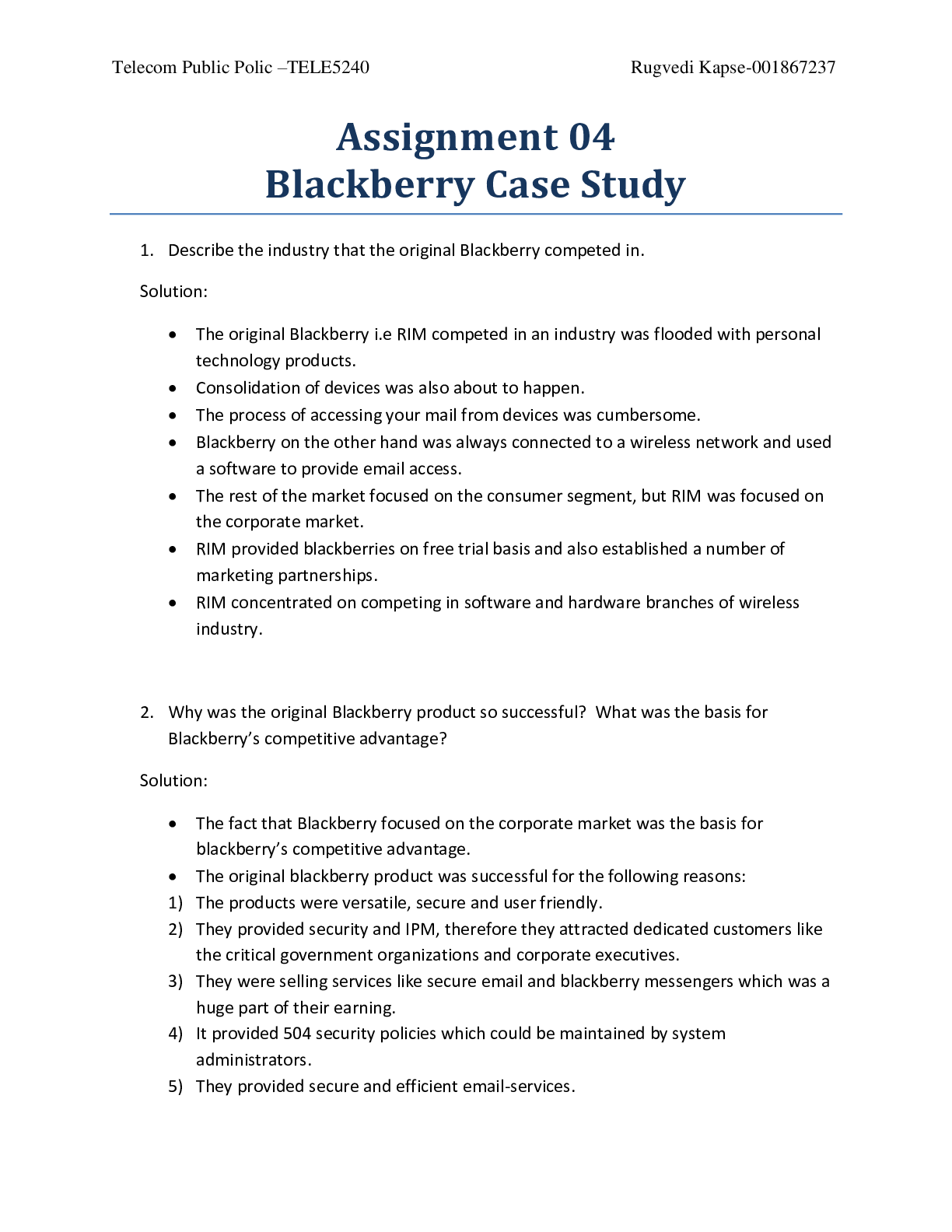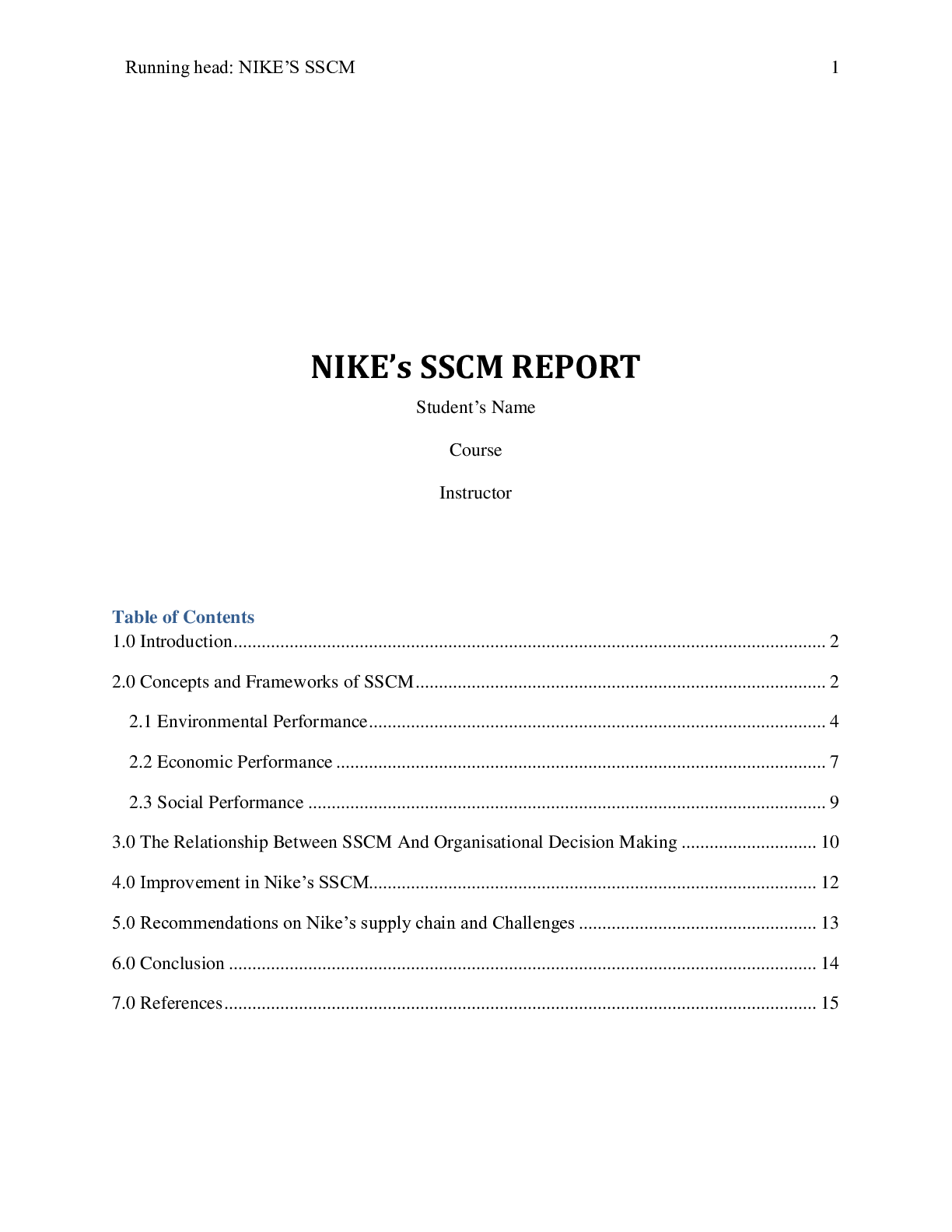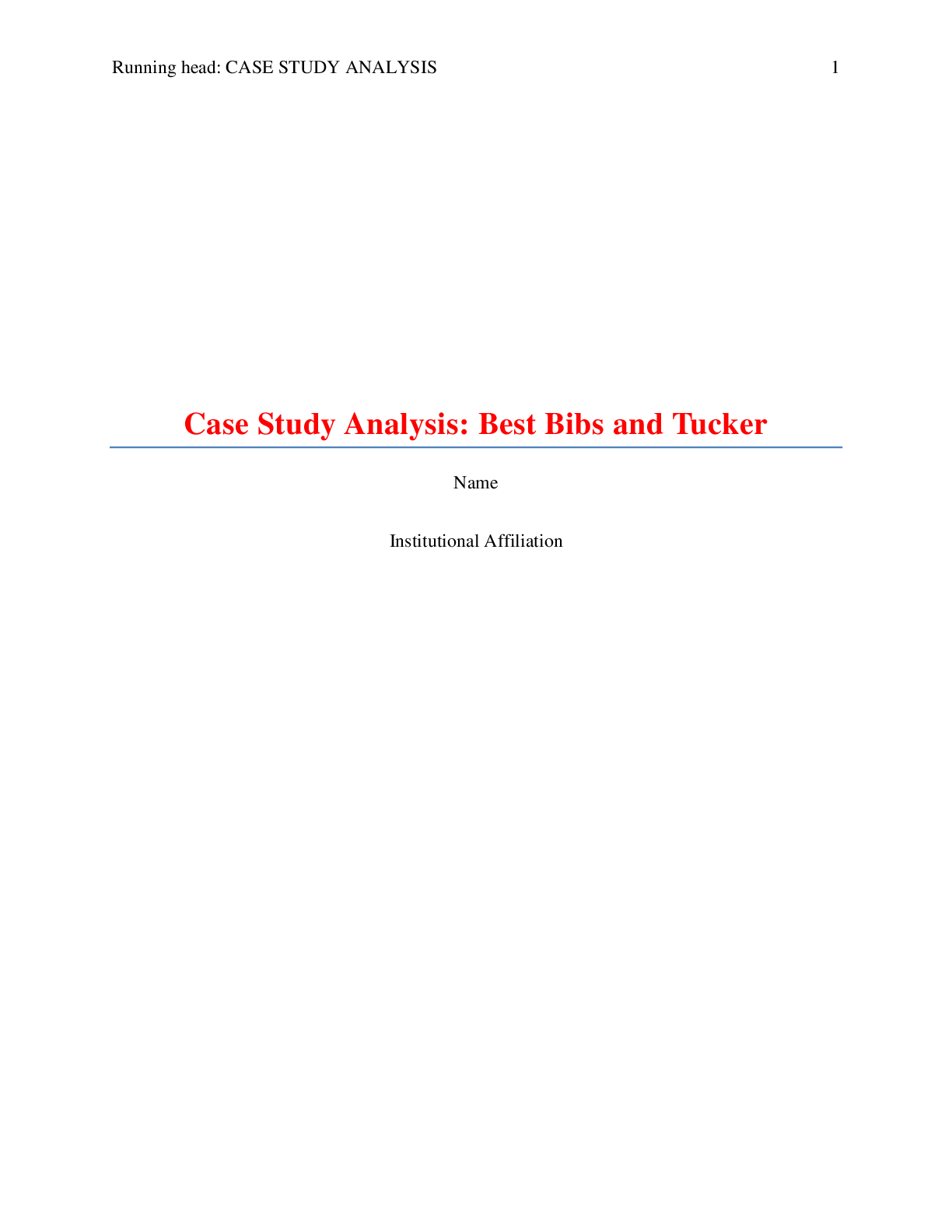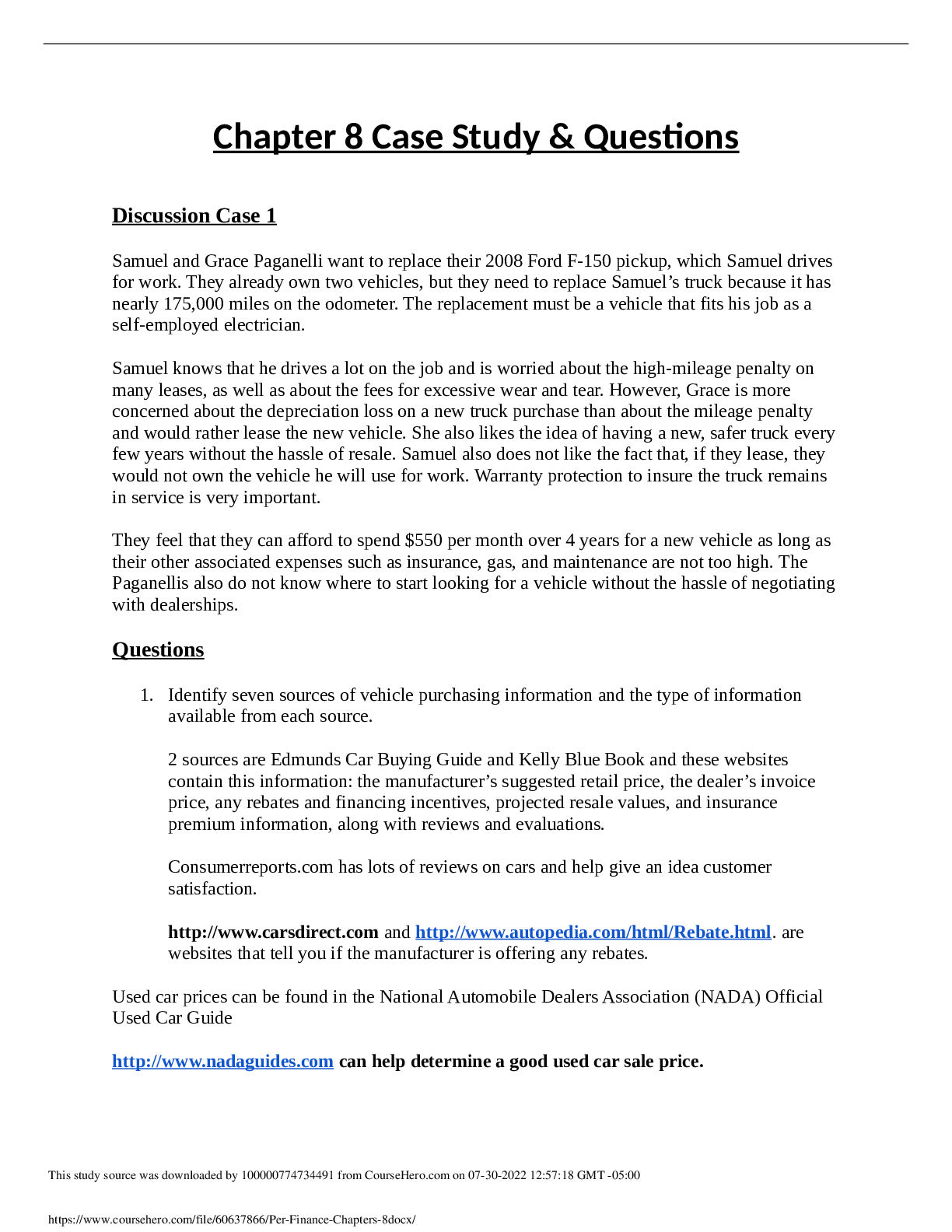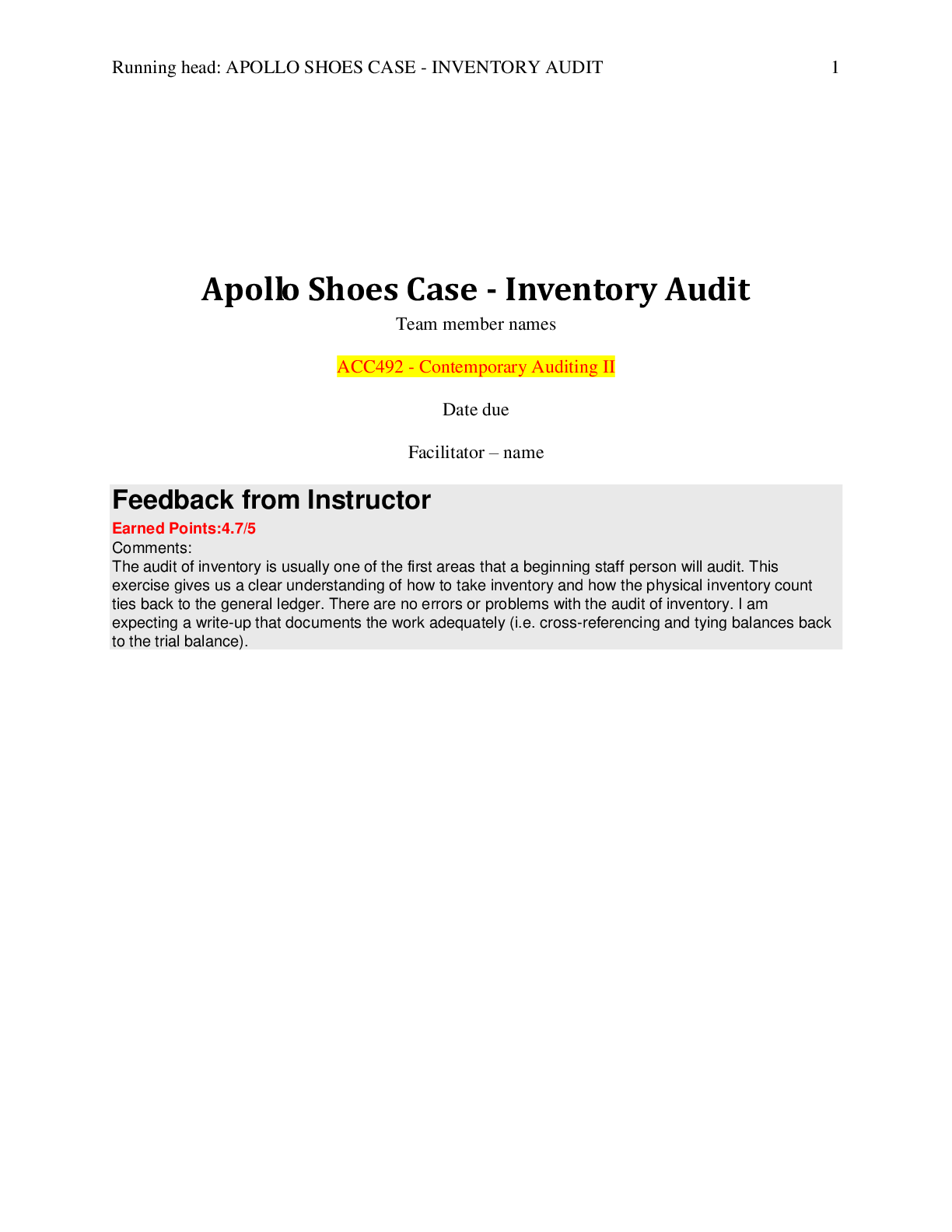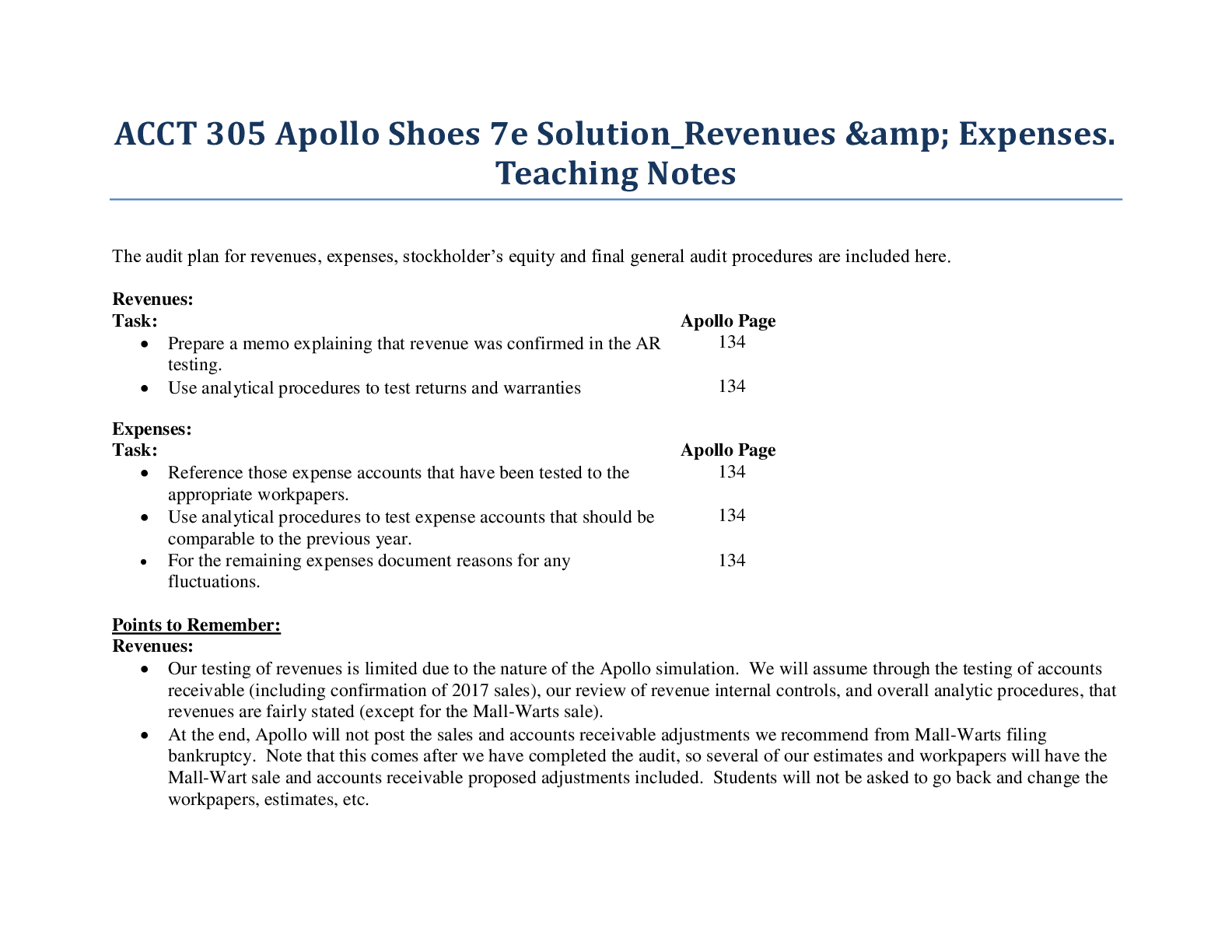Business Administration > CASE STUDY > BHO0202 Managing Organisational Design and Change Group Case Study (LATEST): 40% of Module assessme (All)
BHO0202 Managing Organisational Design and Change Group Case Study (LATEST): 40% of Module assessment. consultant’s report of no more than 5000 words.
Document Content and Description Below
Assignment Brief: • Read the New World Innovations Case study • Your group should assume the role of a team of consultants (Stella Hull Business Associates) supporting analysis of the situation ... at New World Innovations and preparing a report for the company and its board of directors. You should produce a balanced report that includes: 1. A description of the company’s current (March 2018) strategic, quality and operational performance. 2. An analysis and identification of the main issues of strategic, quality and operational concern. 3. A proposal for short, medium and long term improvements to address the issues you have identified in your analysis. 4. Details of performance management. Clearly stating which, how and where you would suggest New World Innovations use performance measures to help manage the change/improvement programme. 5. How New World Innovations will manage the implementation of your short, medium and long term improvement proposals. Diagrams, tables and charts should be used to facilitate discussion and understanding Description of the company’s current strategic, quality and operational performance. Use of relevant, methods tools and theory to support description. (25%) An analysis and identification of the main issues for concern. Use of relevant tools and theory to conduct and communicate the results of the analysis. (25%) A proposal for short, medium and long term improvements to address the strategic, quality and operational performance issues identified. An indication of an appropriate time frame for change should be included. (15%) Appropriateness of the performance measures suggested and identification of intended value of individual measures to the overall improvement strategy. (15%) Appropriateness of change management theory and practical considerations effecting the organisation, tasks and staff. (10%) BHO 0202 Managing Organisational Design and Change Assessed Case Study (2017-18): New World Innovations Background: New World Innovations (NWI) produces electronic office and business equipment. The business started as a hobby by two friends in 2000 and quickly developed a national reputation for quality, innovative and easy to use business and home office products. To finance the subsequent business expansion investors were invited into the business, which has become the established business model for the last ten years. Ownership at present is shared 50-50 between the company founders (the two friends) and a private equity company (investors). The equity company took its share when it financed the take-over of NWI’s main UK rival five years ago. In terms of market share until recently NWI were the market leader in the UK and number four in the European market. However, they have slipped and are now currently the number three in the UK, and number ten in Europe. Of increasing concern to the equity company NWI still has to establish significant sales in the wider world market, though there are opportunities opening in the developing regions. NWI does though have a history of successfully collaborating with world leading suppliers of office equipment. The company has invested heavily over the years in the areas of research and development and in proto-type design. NWI designers and engineers have contributed to the designs of several very successful products. NWI also acts has a sub-contract manufacturer for European and American office equipment manufacturers. The business strategy for the last few years has been focused on developing a range of high quality products that would underpin penetration of the wider world markets and shape business growth. The equity shareholders are particularly focused on growing the business further as quickly as possible. Several months ago NWI launched the Home Office System Hub 2016 (HOSH2016). This is a compact, single, very robust machine that functions as a colour printer, scanner, copier, fax, text and Wi-Fi hub. The HOSH2016 has received rave reviews for its innovative design, functionality and price from trade shows and in the technical press. The customer interest that this generated coupled with the business’s existing reputation for quality, innovative and affordable products have led to a severe backlog in unsatisfied orders. Whilst the Huddersfield factory operates two 8-hour shifts Monday to Friday (0600-1400 & 1400-2200) they simply could not cope with the volume of demand. Current situation February 2018: The performance of the product (HOSH2016) and the Huddersfield factory had been the main item on the agenda at the last executive board meeting (February 2018). Some members of the board had been very critical of the senior management team and the way they had prepared for and managed the product launch. There were even suggestions of sub-contracting the product manufacturing to far eastern suppliers. The managing director was tasked with producing a full analysis for NWI Board of Directors, its position in the market place and future potential for growth. The managing director was also told in no uncertain terms to sort out problems in the factory before they had a serious impact on the business. Before attended the last board meeting (February 2018), NWI’s managing director Beth Davies was extremely concerned with the backlog and put a great deal of pressure on the factory manager, Jimmy Woods, to increase production. However, Beth abruptly changed her focus when a new report showed that returns and complaints were running five times higher for the new HOSH2016 than any other product. With NWI’s reputation on the line and the new pressure from board members Beth decided that this problem needed immediate attention from a number of perspectives. She decided that the best way forward would be to bring in a reputable outside consultant. Interactions: Beth hired Stella Hull Business Associates, a well-established consultancy group, to look into the problem. Beth and Stella met and agreed that Stella should spend a week interviewing key personnel in an effort to learn as much about the problem as possible. Because of the urgency and high profile of the problem Beth promised Stella that she would have complete access to, and the cooperation of, all employees. Beth sent out an email to this effect to all employees working on the HOSH2016 project. She also gave Stella access to any company documentation that she required. Stella started the project by briefing her team of four business analysts. They started work on gaining an understanding of the business and its operating environment. Stella had tasked them with completing a full analysis and producing a report containing this analysis and offering strategic options in time for the next quarterly board meeting (May 2018). Stella decided to focus her attention on the factory performance. She started her work by discussing the quality problems with several of the Production Supervisors. She began with the supervisor of the Final Assembly section, Tim Mcilroy, Tim immediately commented: I received Beth’s email yesterday, and really, the problem with the HOSH2016 does not surprise me. One of the problems we have had in final assembly is the thermosetting plastic casing. Basically, the case is composed of a top and a bottom. The problem is that these two pieces rarely fit properly and we have to force them together. I am sure that this is putting a lot of extra stress on the cases. I have not seen the report on what the quality problems are but I am sure that stress cracked cases and inferior polymers are prominent. One thing though, we never had this problem with the old supplier. Just because purchasing can save a few pounds here and there they have switched to an un-tried maker. What checks and balances are in place to ensure suppliers meet our own quality standards? The meeting with Tim lasted around one hour. After writing up notes from these discussions Stella went off to talk to Tim Belfry, the Production Supervisor. Stella found Tim and a production operator Max Westwood examining one of the machines that automatically fixed electronic components onto circuit boards. Stella introduced herself and asked what the problem was. Tim responded: We have been having a bad time making the printed circuit boards for the new HOSH2016 machines. In comparison to previous products designers have placed the components very close to each other. Really they are too near for this type of production machine to insert them properly. We get lots of components with bent leads or components and boards that are damaged beyond repair. About 30% of all the boards coming off the machine have some problem with them. As a result we spend a lot of time inspecting and reworking the boards. All of these problems were compounded when we got the instruction to run the production machine 20% faster, that is, at maximum speed, in an effort to catch-up the backlog. We are now getting more damaged boards and the machine is breaking down more often, we probably only get 5 hours production time from each 8 hour shift. In terms of the problems you are looking at faulty boards or damaged components are likely to be a major cause. We are doing our best to find and correct all of the defects, but inspecting and reworking the boards is a very tedious task. The workers are putting in lots of extra over-time hours to help us out of the problem. We are all under a lot of pressure to get the boards through to final assembly. My biggest regret is that I did not have more input when they were building the prototypes. They were all hand built by highly skilled technicians. Unfortunately, the prototypes were only built to give the designers feedback on the performance of their design. Had we in production been involved we could have made suggestions, which would have made producing these things easier. It’s not surprising we have lost our UK market leader position. Stella finished off the day by talking to the Factory Manager, Jimmy Woods. Jimmy was in complete agreement with David and Tim and talked at length about the pressures he was under to get product out of the door. He said: The biggest problem is that no one works together here. Purchasing change from good to untried suppliers just to save a few pounds and our designer’s think they are the most important department in NWI and design products we cannot produce. Next day Stella decided to speak to the head of Purchasing, Nancy Lopez, about the casing problem identified by Final Assembly. Nancy explained that changing suppliers had saved £5 per unit. Over the projected first year volume of sales this would improve the margin by £750,000, not a saving to be missed. Nancy said that: The production department think the world revolves around them. They should think about where the savings are really made that keep us all in a job. I know there are some issues with quality from this supplier and I intend to sort it out when I visit them next month. Also, remember our main UK competitor launched a similar product which is £10 cheaper than the HOSH2016. After this conversation Stella went off to see the Engineering Director. On the way she saw the operator (Max Westwood) who had been with Tim the day before. After introducing herself again Stella decided to have a chat as they walked along. Max told her: That he had worked in the Despatch Department until two weeks ago. When the production job became available, he had been told the original operator was off sick with stress; he applied just to get a higher wage. He had not had time to get the proper training yet, they were so busy. Anyway Tim kept an eye on him and had asked the inspectors to do the same. But the inspectors were always complaining, nothing you did ever pleased them, and I’m now wondering if I should go back to the despatch department, because at least we looked after each other, I suppose like a team. Stella thanked the operator and went off to her meeting with Eddie Willett the Engineering Director. Eddie began: I understand you’re here to look at our little quality glitch. In Engineering we are driven to get everything into a smaller and smaller place. A few years ago all of the functions of the HOSH2016 were in individual products now we have to fit it all into one box. That means that tolerances are going to be more exacting and the products are going to be more difficult to make. Manufacturing, I mean Production and Final assembly at the Huddersfield factory really need to get their act together if the business is going to survive in the marketplace. Engineering did its job. We produced a state of the art design in a record time, and proved the prototypes to a standard never achieved before. All manufacturing have to do is put the same effort into producing them. Stella’s final meeting of the day was with Jennifer Wie the Quality Assurance Director. Jennifer stated that: Her biggest challenge was trying to convince the rest of the organisation including NWI owners of the importance of the quality function. Everyone says they are quality focused but come the end of the month the focus is on getting product out of the door. Whilst I have formal responsibility for quality I do not have any authority over the production or assembly area at the Huddersfield factory. The quality inspectors that report to me do little more than check products and tag the ones that need to go off to rework. Because of this I am very happy to see you here. I am glad Beth has at last become concerned about quality and I welcome the opportunity to work with you. What is the point of my role when in reality we at NWI do not engage in a quality ethos? Stella ends the day by writing up her notes from the meetings and interviews. She is aware that there are complex issues to be dealt with. That whilst some of them need immediate attention others will require medium and long term solutions. On returning to head office Stella consults with her team to gain a view of their progress. She intends to produce an interim report for the company that identifies the main strategic, quality and performance issues and suggests possible solutions. Stella is mindful that her report will need to include an immediate action list. A longer term plan for improvement will be included in the final business report for the NWI board (May 2018). References Cameron, E. (2016). Making sense of change management: a complete guide to the models, tools and techniques of ... organizational change. [Place of publication not identified], Kogan Page Stylus. CampbelL, H. (2014). Managing organizational change. Chevalier, J. M., & Buckles, D. J. (2013). Participatory Action Research: Theory and Methods for Engaged Inquiry. Hoboken, Taylor and Francis. http://www.123library.org/book_details/?id=92944. Goksoy, A. (2016). Organizational change management strategies in modern business. Hurst, D. K. (2005). Crisis & renewal: meeting the challenge of organizational change. Boston, Mass, Harvard Business School Press. Tan, H. (2012). Technology for education and learning. Berlin, Springer. http://public.eblib.com/choice/publicfullrecord.aspx?p=885513. Magala, S. (2007). Organizational Change: Over-Psychologized and Under-Socialized? Journal of Organizational Change Management: Volume 20, Issue 3. Emerald Group Publishing. http://www.myilibrary.com?id=92889. Marshak, R. J. (2006). Covert processes at work: managing the five hidden dimensions of organizational change. San Francisco, CA, Berrett-Koehler Publishers. Ostrow, R. (2008). Library culture in the electronic age: a case study of organizational change. Poole, M. S. (2000). Organizational change and innovation processes theory and methods for research. New York, Oxford University Press. http://www.myilibrary.com?id=83330. Poser, S. (2000). Rights, remedies, and organizational change: a theory for school desegregation. Thesis (Ph. D. in Jurisprudence and Social Policy)--University of California, Berkeley, Spring 2000. Putnam, L., &Mumby, D. K. (2014). The Sage handbook of organizational communication: advances in theory, research, and methods. Salerno, A., & Brock, L. (2008). The change cycle: how people can survive and thrive in organizational change. San Francisco, Berrett-Koehler Publishers. http://www.books24x7.com/marc.asp?bookid=23479. Senior, B., &Swailes, S. (2016). Organizational change. Harlow, England, Pearson. Shani, A. B., Noumair, D. A., & Burke, W. W. (2015). Research in organizational change and development. http://www.emeraldinsight.com/0897-3016/23. Voskoboynikov, F. (2017). The psychology of effective management: strategies for relationship building. http://search.ebscohost.com/login.aspx?direct=true&scope=site&db=nlebk&db=nlabk&AN=1424433. [Show More]
Last updated: 1 year ago
Preview 1 out of 25 pages
Instant download
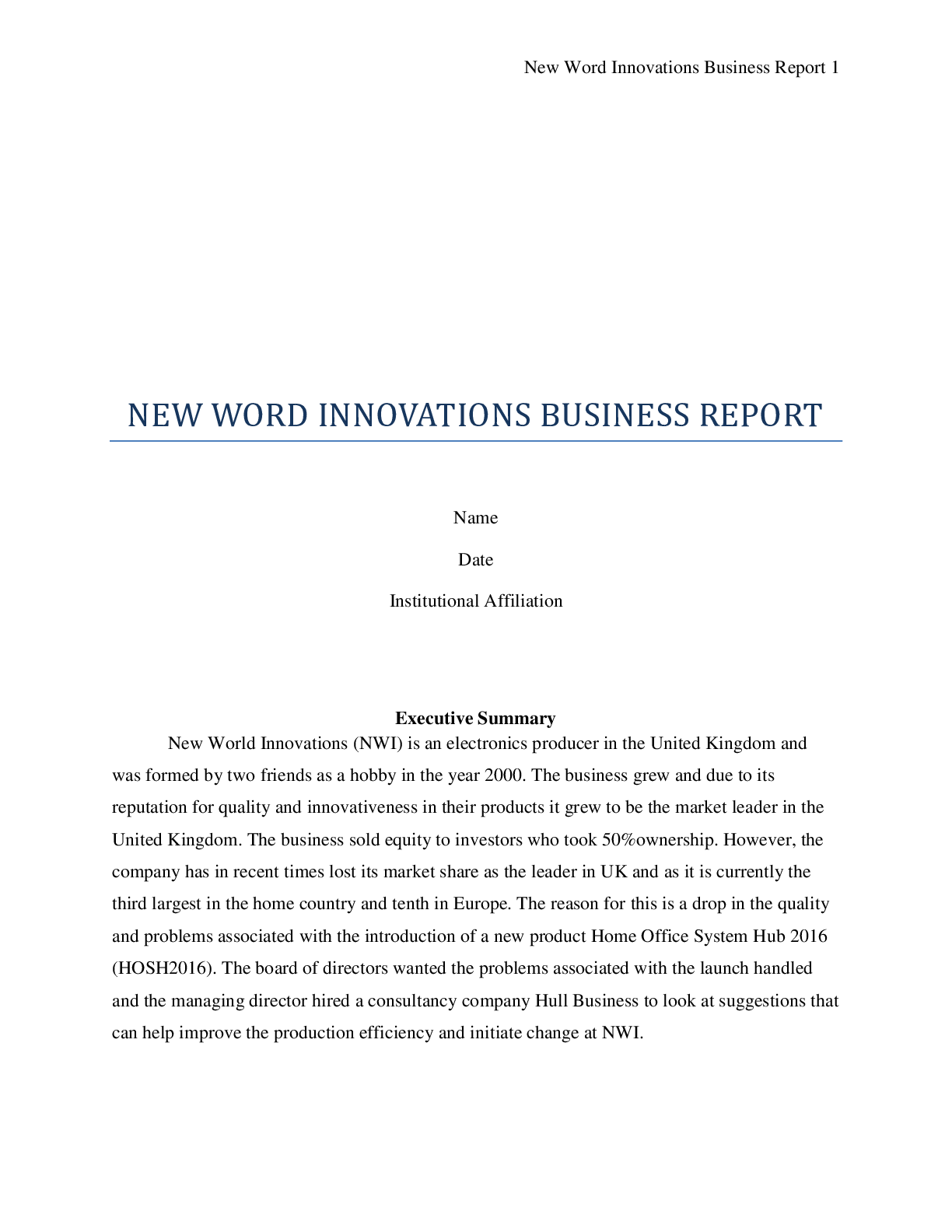
Buy this document to get the full access instantly
Instant Download Access after purchase
Add to cartInstant download
Reviews( 0 )
Document information
Connected school, study & course
About the document
Uploaded On
Jul 07, 2020
Number of pages
25
Written in
Additional information
This document has been written for:
Uploaded
Jul 07, 2020
Downloads
0
Views
67

